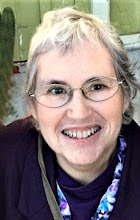Workshop: An
Introduction to Writing for Children and Young Adults
 There
are so many excellent picture book authors that a long list would still not be
able to name all of them. Below are a few of those who have written in the three
categories mentioned last week so you can study the work of one particular
author, if you would like. Or you may already have a favorite author. Choose
one to study and see what voice they carry throughout all their picture books.
Or do they?
There
are so many excellent picture book authors that a long list would still not be
able to name all of them. Below are a few of those who have written in the three
categories mentioned last week so you can study the work of one particular
author, if you would like. Or you may already have a favorite author. Choose
one to study and see what voice they carry throughout all their picture books.
Or do they?
Bryan,
Ashley.
Carle,
Eric.
Lyon,
George Ella. Dreamplace
Root,
Phyllis.
Sis,
Peter. Starry Messenger
Wells,
Rosemary.
As
you study them watch for the following details.
Picture Book
Characteristics
- Text
needs to stand-alone. However full meaning needs illustration.
- Language
needs to be concrete.
- Story
has some kind of conflict. Remember a conflict for this age might appear very
simple but to them it is a problem. A timeless example is a child’s reluctance
to go to bed as so softly addressed in Goodnight
Moon.
- Light
sentences for beginning readers. For example, no description and basic specific words.
- Short
sentences.
- Distinct
beginning, middle, and end.
- End
has a twist. There are some exceptions but generally the twist or surprise is
why the story will sustain repeated reading.
- Brief
or no transition.
- Repetitive
words if they help the story.
- Limited
setting. Illustrations will show.
- Simple
problem.
- Short
time frame.
- External
conflict rather than internal—very important.
- Simple
characters—usually only one defining characteristic such as curious.
- Keep
audience in mind.
- Some
sort of action.
- Important
to keep to essence of story.
Plot
Patterns
Here
are a few patterns to consider as well that engage this audience.
1. The ending
is set up on very first page. Story goes up, story goes down.
2. Circular
story. In Papa’s Bedtime Story, it opens with a baby being rocked to sleep
and moves around the house and farm to see all the baby animals nestling down.
The circle comes back to a mouse family in the house and through their doorway
across the room is the baby from the first frame.
3. For a series
there may be small mini plots with over-arching plot such as the sister stories
Zelda and Ivy.
Other
patterns to consider include the structure of tone such as a “once upon a time”
or modern.
Patterns
include rhythms of words such as short, snappy, or long flowing.
One
writer said that picture books are closest to acting while another writer compared
them as closest to film making.
Action Steps:
1. Choose one of the books you enjoyed the most and one that you didn’t
connect with. Using the list above write down how each book measured up to each
characteristic.
2. If any parts were missing, how would you fill them in?
3. Now apply the same list to your own work in progress. Or if you
haven’t yet, draft a picture book of your own.
Share: What have you noticed so far that
surprised you?
Read deep, marcy
 There
are so many excellent picture book authors that a long list would still not be
able to name all of them. Below are a few of those who have written in the three
categories mentioned last week so you can study the work of one particular
author, if you would like. Or you may already have a favorite author. Choose
one to study and see what voice they carry throughout all their picture books.
Or do they?
There
are so many excellent picture book authors that a long list would still not be
able to name all of them. Below are a few of those who have written in the three
categories mentioned last week so you can study the work of one particular
author, if you would like. Or you may already have a favorite author. Choose
one to study and see what voice they carry throughout all their picture books.
Or do they?







No comments:
Post a Comment